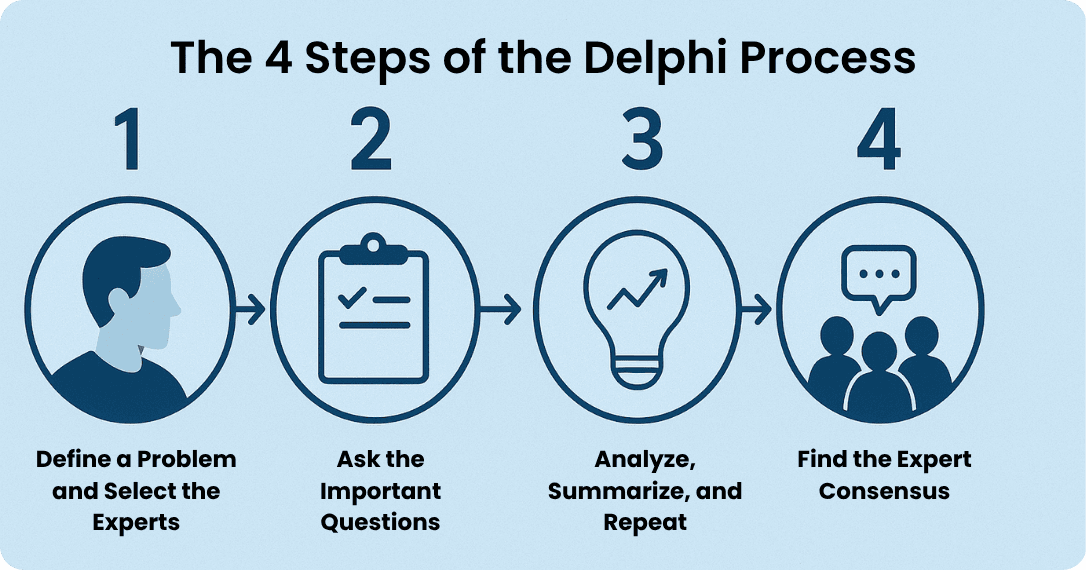

Delphi Method: The Definitive Guide

22 October, 2025
Share this article
Table of Contents
The future is hard to predict.
Unfortunately, there’s no crystal ball that can tell us exactly what will happen. Yet, there are structured methods that help us see complex problems and uncertain futures more clearly.
One of them is the Delphi technique, a structured communication tool that has become essential for professionals who need better forecasting accuracy, improved decision-making, and strong expert consensus.
In this article, you’ll learn what the Delphi method is, how the Delphi process works, why it’s so valuable, and how you can apply it to make smarter strategic decisions.
What is the Delphi Method?
Brief history of the Delphi Method
The Delphi method was born in a very specific context: the search for better forecasting accuracy in science, technology, and defense.
It was developed by RAND Corporation researchers during the Cold War to anticipate the development of new weapons and technologies.
However, its flexible and expert-driven nature made it a valuable tool across virtually any industry. From tech innovation to policymaking, the applications of the Delphi method have proven its power as a structured way to think collectively about the future.
Its name comes from the ancient Oracle of Delphi, known for its predictions of the future. The difference is that the Delphi process replaces myth with a rational, collaborative, and evidence-based approach.
The Delphi Method
The Delphi technique is a structured communication approach used to forecast, analyze, and make informed decisions in complex environments.
It brings together insights from a panel of experts and transforms them into a collective vision. This collective intelligence often produces more valuable outcomes than any single opinion alone.
Unlike open brainstorming sessions or in-person meetings, the Delphi method relies on multiple rounds of anonymous questionnaires where experts independently share their judgments.
In short, it’s an organized way to harness collective intelligence to anticipate change and build faster alignment across decision-makers.

The 4 steps of the Delphi Process
Step 1. Define a Problem and Select a Panel of Experts
The first step is to clearly define the purpose of the study and the people who will take part in it:
- Start by identifying the problem or topic to analyze. It can involve technology forecasting, strategic planning, or risk assessment.
- Next, assemble a panel of experts with the experience and knowledge to explore the issue in depth. The goal isn’t to gather many people, but those who can bring diverse and valuable perspectives.
- Then, assign a moderator capable of synthesizing insights and communicating them clearly. In most cases, the organizer takes this role since they best understand the goals and challenges of the process.
Step 2. Ask the Important Questions
Every good discussion begins with a great question.
That is why the next step is to design an initial questionnaire that captures each expert’s opinions, forecasts, or judgments. It should be clear, focused, and structured to avoid influencing responses.
Each expert answers independently, without knowing who else is participating. This anonymity is one of the defining characteristics of the Delphi method and a key reason for its credibility across industries.
Step 3. Analyze, Summarize and Repeat
Once the responses are collected, the moderator analyzes them and prepares a summary of the findings: highlighting statistics, trends, agreements, and disagreements among experts.
This step allows the moderator to identify key insights and guide the group toward concrete, evidence-based conclusions.
The summary is then shared again with the group. Each expert reviews their opinions in light of others’ feedback, allowing the Delphi process to evolve through informed reflection.
This iterative process continues until responses begin to converge toward a shared understanding or a strong consensus.
Step 4. Find the Expert Consensus
The process ends when answers stabilize between rounds or when the consensus is strong enough to inform confident decision-making.
Finally, the moderator consolidates the results into a report that may include charts, key data, and conclusions derived throughout the Delphi process.

A Practical Example of the Delphi Method in Action
Picture a small café with excellent food but declining sales. Fewer customers walk in, tables remain empty during peak hours, and positive reviews don’t translate into actual traffic.
The following example shows, step by step, how the Delphi technique can be applied using concrete questions, formats, and decisions:
- Define the core problem precisely. For instance: “What are the most likely causes of the sales decline in the last six months, and what changes in the offer or customer experience could reverse that trend within half a year?”. Next comes gathering a panel of experts: local restaurant owners, experienced business managers, and people who understand consumer behavior in the area.
- The first questionnaire should include focused, informed questions such as “What internal factors might have caused the sales drop?” or “What shifts in local consumer habits have you noticed over the past 12 months?”
- The moderator or central team then collects and synthesizes the responses. Common ideas might include new café competitors, economic changes, or weak digital visibility. Feedback is then shared back to the panel of experts and the process is repeated.
- Once consensus emerges, the insights are translated into actionable decisions. Suppose the group identifies low digital visibility and a growing demand for takeaway formats. The café could respond by joining delivery platforms, adding a “grab and go” menu, and launching a social media campaign.
Key Characteristics of the Delphi Method
Behind the simplicity of the process lie three key characteristics of the Delphi method that make it so effective.
- Anonymity: Each participant answers independently, which eliminates the pressure of hierarchy and allows for more authentic responses.
- Iterative Process: the Delphi technique thrives on iteration. It’s not a one-time consultation, but a cycle of multiple rounds that refine insights until a strong expert consensus is reached.
- Controlled environment: All participants receive the same questions, ensuring consistency and minimizing distractions or tangential discussions. This control over language and structure is essential to the method’s reliability.
Applications of the Delphi Method
While originally developed in benefit of the US defense department, the Delphi Process continues to be used in a multitude of sectors due to its impact on strategic planning and forecasting of market trends.
Technology
The Method can be used to identify which emerging technologies will have the greatest impact over the next five years or to assess risks tied to new implementations.
It is also valuable in product planning, such as developing new mobile apps. It helps teams overcome creative blocks and achieve faster alignment on user experience challenges.
Human Resources and People Management
The field of human resources is undergoing constant transformation. New work models, hybrid structures, and generational expectations are redefining talent management.
In this context, the Delphi method can serve as a strategic tool to anticipate how work will evolve and what organizations need to adapt effectively.
For example, it can help predict in-demand skills, redesign company culture, or assess the impact of artificial intelligence on workforce dynamics.
Education
The education sector often faces tough questions: What skills should be taught for the future of work? How can technology be balanced with human teaching? Which learning models will be most effective in the next decade?
The Delphi technique brings together teachers, researchers, curriculum designers, and education experts to collectively reflect on these long-term challenges.
In the public sector, decisions often have a wide and lasting impact. Governments deal with complex problems where perfect solutions rarely exist.
Public Policy
In the public sector, decisions often have a wide and lasting impact. Governments deal with complex problems where perfect solutions rarely exist.
This is why the Delphi process offers an ideal framework to evaluate scenarios, design long-term strategies, and build expert consensus among diverse political stakeholders.

3 tips for implementing the Delphi process
Diversify your panel of experts
Reaching an expert consensus requires a mix of perspectives. Avoid choosing people who think exactly alike. For example, even if your business mainly targets millennials, having a Gen Z voice on your panel can reveal new consumer behaviors or digital habits you might be overlooking.
Likewise, balance strategic thinkers with technical profiles. Including someone from engineering or data science can help clarify what is and isn’t feasible before you move forward with a big idea. Diversity of thought creates more accurate forecasts and better decision-making.
Do appropriate research beforehand (especially if you play the role of facilitator)
The success of the Delphi process depends on the quality of your questions. These should reflect the real challenges and outcomes you’re aiming for. Before you start, research the topic deeply: what data already exists? What gaps are still unclear?
If you’re leading the process, you can use tools like Google Forms, Typeform, or SurveyMonkey to structure your questionnaires. Platforms like Miro or Notion can help you visualize patterns and summarize feedback more easily between rounds. This preparation ensures faster alignment and keeps discussions focused.
Focus on clear, attainable goals
Don’t start a Delphi process without defining what “success” looks like. For instance, your goal might be to forecast emerging trends in your industry, identify the top three strategic priorities for next year, or assess the risks of launching a new product.
The Delphi technique works best when applied to specific problems that require expert judgment and collective intelligence, not when the question is too broad or vague.
Think practical, think measurable. If your goals are clear, the iterative process of gathering and refining expert insights will lead to better forecasting accuracy and more confident decision-making.
Remote work
Keep up to date with our most recent articles, events and all that Pluria has to offer you.
By subscribing to the newsletter you agree with the privacy policy.

The future is hard to predict.
Unfortunately, there’s no crystal ball that can tell us exactly what will happen. Yet, there are structured methods that[...]
22 October, 2025
In today’s fast-paced business environment, projects move faster than ever before.
Customer expectations shift constantly, new competitors enter [...]
29 October, 2025
More often than not, the best ideas do not develop in a linear fashion.
As a matter of fact, they usually emerge from a single word, an unexpected conn[...]
07 November, 2025